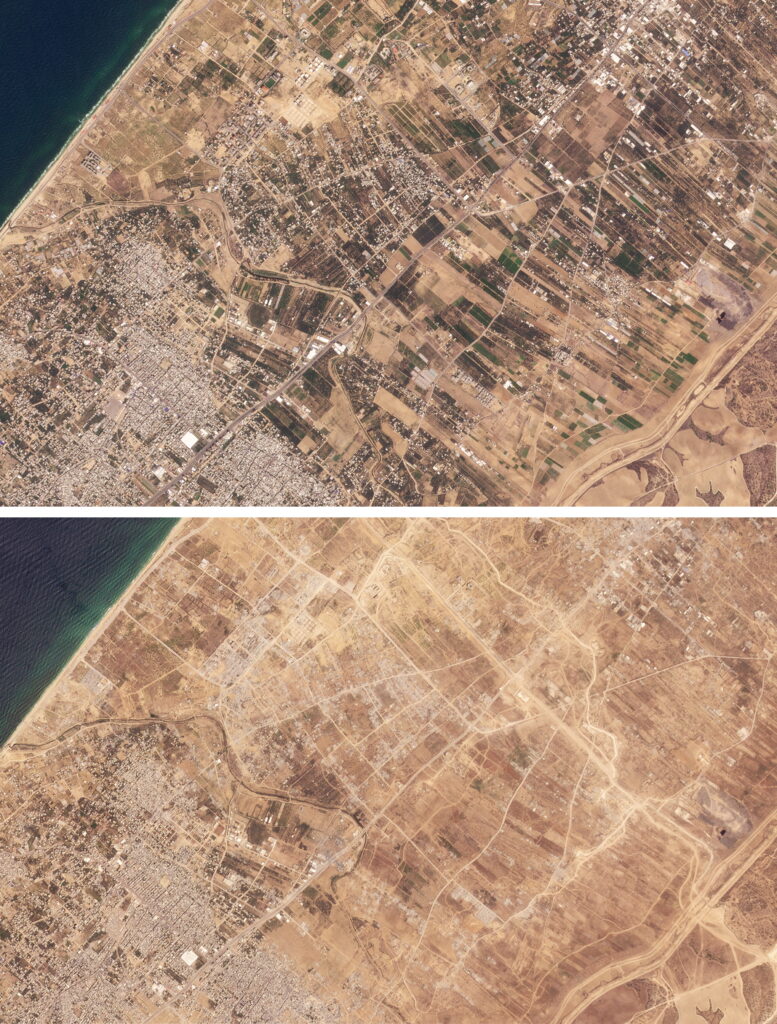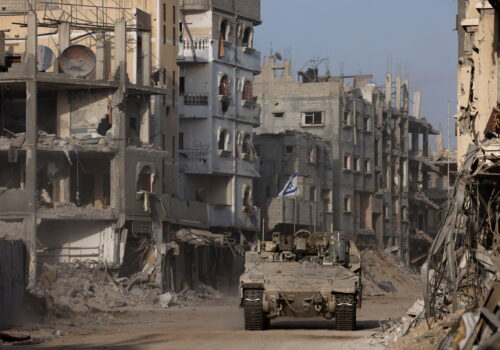The Netzarim Corridor: Tragedy, death, and an obstacle to a lasting ceasefire
Disturbing and deeply troubling accounts have emerged from a Haaretz investigation published in December that details the brutal and seemingly indiscriminate application of Israeli firepower in the Netzarim Corridor. The investigation included interviews with current and former Israel Defense Forces (IDF) soldiers, officers, and commanders serving or who have served in the Gaza Strip. The Netzarim Corridor, a part of Gaza that has been under IDF control since November 2023, split Gaza in two, separating the coastal enclave’s north from the rest of the strip. The report describes what has been alleged time and again throughout the war: an imaginary line has been drawn up by IDF field commanders beyond which anyone passing through is to be shot and killed immediately.
The Israeli military has designated the two access points to the Netzarim Corridor as no-go zones to provide force protection for troops inside the zone, threatening to shoot those “trespassing” the area around the Salah al-Din Road in central Gaza and the Al-Rashid coastal highway, where most of the civilian population has been moving out of the north and heading south.
The corridor has become significant because those seeking to leave northern Gaza have been forced to pass through it on their journey south. Meanwhile, those facing cramped and unbearable humanitarian conditions in the crowded central and southern Gaza seeking to take their chances on returning to what’s left of Gaza’s north attempt to traverse the deadly corridor. As ceasefire negotiations appear to be making progress, the incoming Trump administration must ensure that any deal, regardless of its phased implementation, includes mechanisms for protecting Palestinian civilians traversing the corridor to return to their homes and monitoring the IDF’s compliance with the terms of the agreement.
SIGN UP FOR THIS WEEK IN THE MIDEAST NEWSLETTER
A sobering investigation

The Haaretz investigation describes in harrowing detail how civilians were repeatedly targeted by careless, reckless, and, in a few instances, even joyous soldiers who applied overwhelming firepower against civilian targets who were clearly visible through drones and cameras as nonthreatening people, only to be mercilessly and ruthlessly gunned down without any apparent military necessity.
Time and again, the officers, soldiers, and commanders interviewed describe how arbitrarily designated kill zones were regularly littered with dead Palestinian bodies who were counted as “terrorists” without any confirmation of their identities, affiliations, crimes, or wrongdoing. Israeli officials regularly assert that IDF attacks and operations only strike military targets based on intelligence, battlefield assessments, and reactions to incidents and threats. Though this claim has been repeatedly challenged by evidence, footage, and even the IDF’s own admission at times, the Israeli government maintains that it vigorously investigates incidents and takes appropriate action against soldiers who violate established codes of conduct and rules of engagement.
However, the report details how the excessive use of helicopters, drones, tanks, and hundreds of bullets was regularly deployed against targets that did not pose an imminent threat and likely could have been spared with simple warning shots instead of being obliterated. Even when those killed were confirmed not to be militants based on IDF intelligence databases, murdered civilians were added to a daily count of eliminated combatants, left to be eaten by packs of stray dogs, as some officers congratulated their soldiers on a supposed job well done.
Despite the details being difficult and depressing to read, perhaps the silver lining throughout was that there are still IDF soldiers with consciousness, awareness, and recognition of the horrors that they are technically part of who are speaking out. They wanted to defend their people after the October 7 massacre but feel that the Israeli public deserves to know the full picture of the brutality that some of their soldiers and commanders are committing. They questioned their orders and the necessity of what they were doing, knowing that they would have to live with the consequences of what they were witnessing for the rest of their lives.
If Israel doesn’t trust any external mechanism for legal accountability for its conduct in Gaza, then the only way that its internal checks and balances can work is for brave soldiers to speak out against war crimes and for courageous journalists to expose these stories so that there can at least be a record of what took place.
What’s next for the corridor?
There are intensive rounds of negotiations to reach a new ceasefire agreement between Israel and Hamas, though it remains unclear whether this could occur in the final days of the Biden administration or in the early days of the incoming Trump administration. Regardless of when such an agreement may be struck, serious questions will have to be answered about the Netzarim Corridor and Palestinian civilians’ ability to return to northern Gaza. Some reports suggest that as part of pending negotiations, Palestinian civilians would be able to return north without conditions, but vehicles would be inspected in accordance with a new mechanism. This would necessitate a partial or complete withdrawal of IDF troops from the corridor, something that is difficult to envision after the Israeli military expanded the corridor last month to vast areas and built more than a dozen bases throughout the space, which encompasses over twenty-one square miles of the coastal enclave’s territory.
The incoming Trump administration will have to wrestle with tactical-level details—especially what happens with the Netzarim Corridor and civilians’ return to the north—if it wants to play a role in mediating a ceasefire and ending the war. The carnage associated with the forced deportation of Palestinian civilians from the north and the prevention of their return has been an exceptionally bloody chapter in this war; the road to Gaza’s recovery and the prospects for lasting peace will require addressing this issue.
President-elect Donald Trump’s incoming secretary of state, working with special envoys and the National Security Council, should ensure the inclusion of specific guidelines for how the corridor—and indeed, all territories held by Israel during a ceasefire—would be administered and secured. This would entail pushing for stricter rules of engagement that involve higher-ups in the chain of command, higher thresholds for engaging suspects, mechanisms for issuing warnings before opening fire, and a clear strategy for how to discriminate targets based on a tangible threat matrix, not hunches or an overzealous field officer and commander.
Additionally, if the IDF maintains a presence in the corridor or other parts of Gaza that would be traversed by civilians seeking to return to their neighborhoods, there should be a mechanism for an independent observer, including regional players with US support, who could assess the behavior and compliance of Israeli soldiers with the ceasefire agreement, much like what the United States is doing in southern Lebanon.
The incoming Trump administration can play a positive role in dialing back some of the battlefield excesses that have caused immense, unnecessary loss of life to Palestinian civilians. The testimonies of IDF soldiers should give serious pause to policymakers, who must register the irreparable geopolitical damage that these stories inflict on regional stability and the hope for lasting peace between Palestinians and Israelis.
Ahmed Fouad Alkhatib is a resident senior fellow with the Scowcroft Middle East Security Initiative at the Atlantic Council’s Middle East Programs.
Further reading
Fri, Oct 4, 2024
One year after Hamas’s October 7 terrorist attacks, here’s how the region has changed
MENASource By
One year on, the Gaza War remains unresolved and the potential for war across the region is becoming more likely. Atlantic Council experts take on questions about the war's impact—and its future.
Fri, Dec 6, 2024
What lies ahead for the Israel-Hamas war—and what the United States should do about it
MENASource By
As the Israel-Hamas conflict continues to evolve, the incoming Donald Trump administration will need to adopt a nuanced and forward-looking approach that builds upon prior efforts to avoid further destabilization.
Wed, Nov 27, 2024
War, peace, or a perpetual state of crisis—three possible paths for the Middle East’s future
MENASource By
The ongoing debate between escalation and de-escalation reveals the complexity of the region’s geopolitics and the different perspectives on future conflicts.
Image: Israeli Prime Minister Benjamin Netanyahu visits the Netzarim Corridor in Gaza, on November 19, 2024. Photo by GPO via Balkis Press/ABACAPRESS.COM


